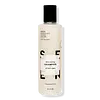What's inside
What's inside
 Key Ingredients
Key Ingredients

No key ingredients
 Benefits
Benefits

No benefits
 Concerns
Concerns

No concerns
 Ingredients Side-by-side
Ingredients Side-by-side

Zinc Pyrithione 1%
AntiseborrhoeicCocamidopropyl Betaine
CleansingWater
Skin ConditioningSodium Xylenesulfonate
Sodium Lauryl Sulfate
CleansingParfum
MaskingSodium Laureth Sulfate
CleansingSodium Benzoate
MaskingGlycol Distearate
EmollientGuar Hydroxypropyltrimonium Chloride
Skin ConditioningSodium Chloride
MaskingMagnesium Carbonate Hydroxide
BufferingZinc Carbonate
Blue 1 Lake
Cosmetic ColorantDimethicone
EmollientCI 17200
Cosmetic ColorantZinc Pyrithione 1%, Cocamidopropyl Betaine, Water, Sodium Xylenesulfonate, Sodium Lauryl Sulfate, Parfum, Sodium Laureth Sulfate, Sodium Benzoate, Glycol Distearate, Guar Hydroxypropyltrimonium Chloride, Sodium Chloride, Magnesium Carbonate Hydroxide, Zinc Carbonate, Blue 1 Lake, Dimethicone, CI 17200
Water
Skin ConditioningSodium Lauroyl Methyl Isethionate
CleansingCocamidopropylamine Oxide
CleansingGlycerin
HumectantAcrylates Copolymer
Glycol Distearate
EmollientTrisodium Ethylenediamine Disuccinate
C13-15 Alkane
SolventGuar Hydroxypropyltrimonium Chloride
Skin ConditioningPolyquaternium-7
Bisabolol
MaskingCitric Acid
BufferingDisodium EDTA
Phenoxyethanol
PreservativeEthylhexylglycerin
Skin ConditioningAminomethyl Propanol
BufferingSodium Hydroxide
BufferingTocopherol
AntioxidantSodium Benzoate
MaskingWater, Sodium Lauroyl Methyl Isethionate, Cocamidopropylamine Oxide, Glycerin, Acrylates Copolymer, Glycol Distearate, Trisodium Ethylenediamine Disuccinate, C13-15 Alkane, Guar Hydroxypropyltrimonium Chloride, Polyquaternium-7, Bisabolol, Citric Acid, Disodium EDTA, Phenoxyethanol, Ethylhexylglycerin, Aminomethyl Propanol, Sodium Hydroxide, Tocopherol, Sodium Benzoate
 Reviews
Reviews

Ingredients Explained
These ingredients are found in both products.
Ingredients higher up in an ingredient list are typically present in a larger amount.
Glycol Distearate serves as a pearlizing or opacifying agent in cosmetic products.
It's often included in cleansers and haircare products to give them a lustrous or shimmering appearance.
It is derived from stearic acid, a natural fatty acid commonly found in vegetable oils and animal fats.
Glycol Distearate isn't fungal acne safe.
Learn more about Glycol DistearateThis ingredient is derived from guar gum.
It is a conditioning ingredient, meaning it helps soften skin and hair.
Sodium Benzoate is a preservative. It's used in both cosmetic and food products to inhibit the growth of mold and bacteria. It is typically produced synthetically.
Both the US FDA and EU Health Committee have approved the use of sodium benzoate. In the US, levels of 0.1% (of the total product) are allowed.
Sodium benzoate works as a preservative by inhibiting the growth of bacteria inside of cells. It prevents the cell from fermenting a type of sugar using an enzyme called phosphofructokinase.
It is the salt of benzoic acid. Foods containing sodium benzoate include soda, salad dressings, condiments, fruit juices, wines, and snack foods.
Studies for using ascorbic acid and sodium benzoate in cosmetics are lacking, especially in skincare routines with multiple steps.
We always recommend speaking with a professional, such as a dermatologist, if you have any concerns.
Learn more about Sodium BenzoateWater. It's the most common cosmetic ingredient of all. You'll usually see it at the top of ingredient lists, meaning that it makes up the largest part of the product.
So why is it so popular? Water most often acts as a solvent - this means that it helps dissolve other ingredients into the formulation.
You'll also recognize water as that liquid we all need to stay alive. If you see this, drink a glass of water. Stay hydrated!
Learn more about Water